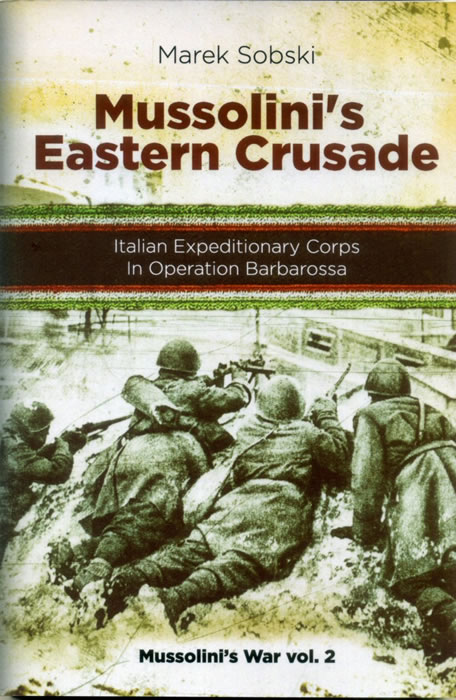|
|
|
|
| Home > Reviews > Axis > Mussolini's Eastern Crusade - Italian Expeditionary Corps in Operation Barbarossa. Mussolini's War vol.2 by Marek Sobski |
Mussolini's Eastern Crusade - Italian Expeditionary Corps in Operation Barbarossa. Mussolini's War Vol.2
by Marek Sobski
Reviewed by Peter Brown
Summary
Title: |
Mussolini's Eastern Crusade by Marek Sobski Published by http://wojna-mussoliniego.pl |
ISBN: |
9798480926569 |
Media and Contents: |
465 pages |
Price: |
Hard Copy Available via Amazon, UK price £15.42 plus postage also available as Kindle version. |
Review Type: |
First Read |
Advantages: |
A detailed and comprehensive study. |
Disadvantages: |
|
Recommendation: |
What we have here sheds light on what to many is an unknown part of the Second World War. Useful appendices include an extensive bibliography for those wishing to know more although most are in Italian or Polish. Photos and maps are also included. |
FirstRead
Germany's invasion of the Soviet Union code-named Operation Barbarossa is well covered in print. Less well known is the part played by Hitler's allies in this and the subsequent campaign. One country which also sent forces was Italy. Its Fascist leader Benito Mussolini wanted to play a part in the Great Anti-Communist Crusade for a number of reasons. What these were and what their outcome was is covered in the second book in this series on Italy's military actions under him.
The account begins with a brief outline of relations between Italy and the USSR from the 1920s to the time of the invasion, followed by an analysis of the reasons for the Italian participation. At the end of May 1941 the formation of the Corpo Spedizione Italiano in Russia began. The units allocated to the CSIR are listed and their routes to the front followed. Also covered are basic details of Soviet forces.
Italian forces fought alongside the Germans in several battles and smaller actions. They met with success in many cases. They were hampered by their equipment, many units lacked vehicles so were forced to march. Machine guns did not function in harsh winter conditions though with better clothing they suffered fewer frostbite losses than the Germans. Flying aircraft with open cockpits was not easy in winter. Armoured vehicles were outclassed by even the oldest Russian ones and they had few submachine guns, relying on those they captured.
At the end of 1941 the decision was made to expand to a full Army instead of just a Corps. This was to take months but resulted in the formation of the 8th Army. Coverage of that will be in a later book in the series.
What we have here sheds light on what to many is an unknown part of the Second World War. Useful appendices include an extensive bibliography for those wishing to know more although most are in Italian or Polish. Photos and maps are also included.
Reviewer's footnote - I played a part in the preparation of this book as I was proof reader to the translation from Polish by Tomasz Basarabowicz.
Peter Brown 5 March, 2022
Text and Images by Peter Brown
Page Created 14 February, 2021
Page Last Updated
9 April, 2022


